| Article ID | Journal | Published Year | Pages | File Type |
|---|---|---|---|---|
| 4463937 | Global and Planetary Change | 2010 | 9 Pages |
The mass contribution to Mediterranean Sea level variability is estimated from steric-corrected altimetry and from GRACE observations for the period August 2002 to December 2006. The two signals are highly correlated (0.8) and display coherent trends, provided that a proper spatial averaging kernel is used to extract the gravity signal from GRACE coefficients (the same filter is applied to all fields in order to obtain consistent and comparable signals). The good agreement between GRACE observations and steric-corrected altimetry supports the quantification of the long-term mass contribution in terms of non-steric sea level in the Mediterranean. For the past decades, total sea level fields are reconstructed using a reduced-space optimal interpolation of altimetry and tide gauge data. The steric component is evaluated from hydrographic observations available for the same period for the upper 700 m. The errors associated with total sea level and the steric component are evaluated in order to obtain the uncertainty of non-steric sea level. Results indicate that the mass content of the Mediterranean basin has increased at a rate of 0.8 ± 0.1 mm/yr for the period 1948–2000. When the effect of the atmospheric pressure is removed, the trend of the mass component increases up to 1.2 ± 0.2 mm/yr.
